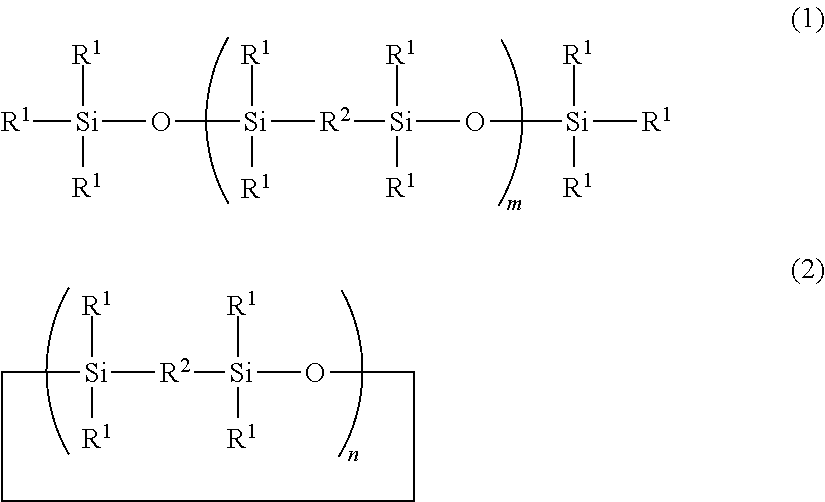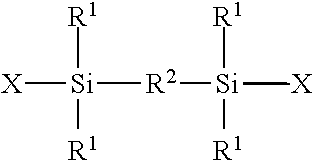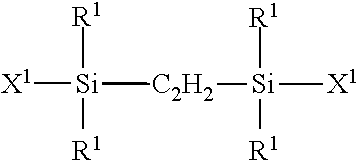Linear And Cyclic Siloxanes And Cosmetic Compositions Made Thereof
a technology of cyclic siloxanes and compositions, applied in the field of new organopolysiloxane, can solve the problems of affecting the sensing of use, unable to obtain d5, and exhibiting stickiness, and achieves superior stability, superior glossiness, and low polymerization. degree
- Summary
- Abstract
- Description
- Claims
- Application Information
AI Technical Summary
Benefits of technology
Problems solved by technology
Method used
Image
Examples
example 1a
[0110]Preparation of 1,2-bis(pentamethyldisiloxy)ethane
[0111]A mixture of 100 g of a 33% solution of 1,2-bis(chlorodimethylsilyl)ethane in toluene and 10 g of water was reacted for 6 hours at 90° C. to completely hydrolyze the chlorosilane, and then cooled. A mixture of 375 g of hexamethyldisiloxane which was an excess amount and 0.1 g of trifluoromethanesulfonic acid was heated to 50° C., and the hydrolysate obtained above was added thereto dropwise, followed by aging for 2 hours. The obtained mixture was washed with water until the wash liquid exhibited neutrality. The resultant mixture was distilled. Thereby, 1,2-bis(pentamethyldisiloxy)ethane represented by the following formula:
was obtained. The boiling point thereof was 109° C. / 20 torr and the yield was 29.8 g (yield =61%).
example 1b
[0112]Preparation of 1,2-bis(pentamethyldisiloxy)ethane
[0113]294.9 g of hexamethyldisiloxane, 87.38 g of acetic acid and 0.13 g of trifluoromethanesulfonic acid were placed in a flask, and the mixture was heated to 45° C. 150 g of 1,2-bis(dimethylmethoxysilyl)ethane was added thereto dropwise. After the dropwise addition was completed, aging was carried out for one hour. It was confirmed that the raw materials had disappeared by means of gas chromatography. The obtained mixture was washed with water until the wash liquid exhibited neutrality. The resultant mixture was distilled. Thereby, 1,2-bis(pentamethyldisiloxy)ethane was obtained. The yield was 79.7 g (yield=34%).
[0114]1,2-bis(pentamethyldisiloxy)ethane synthesized in Example la and Example lb was analyzed by means of gas chromatography. As a result, the purity was 99.2%. In addition, confirmation of the structure thereof was carried out by means of 29Si-NMR (δ: 7.09 (2Si); 8.52 (2Si)) and 13C-NMR (δ: −0.28 (4C); 2.04 (6C); 9.9...
example 2
[0115]Preparation of 1,1,3,3,6,6,8,8-octamethyl-2,7-dioxy-1,3,6,8-tetrasilacyclodecane
[0116]Hydrolysis was carried out with 100 g of a 33% solution of 1,2-bis(chlorodimethylsilyl)ethane in toluene and 10 g of water, and aging was carried out for 6 hours at 90° C. The obtained mixture was washed with water until the wash liquid exhibited neutrality. The resultant mixture was distilled. Thereby, a large cyclic compound represented by the following formula:
(wherein n=2) was obtained. The boiling point thereof was 125° C. / 20 torr, and the yield was 17.2 g (yield=35%).
PUM
| Property | Measurement | Unit |
|---|---|---|
| particle size | aaaaa | aaaaa |
| weight | aaaaa | aaaaa |
| hydrophobic | aaaaa | aaaaa |
Abstract
Description
Claims
Application Information
 Login to View More
Login to View More - R&D
- Intellectual Property
- Life Sciences
- Materials
- Tech Scout
- Unparalleled Data Quality
- Higher Quality Content
- 60% Fewer Hallucinations
Browse by: Latest US Patents, China's latest patents, Technical Efficacy Thesaurus, Application Domain, Technology Topic, Popular Technical Reports.
© 2025 PatSnap. All rights reserved.Legal|Privacy policy|Modern Slavery Act Transparency Statement|Sitemap|About US| Contact US: help@patsnap.com



